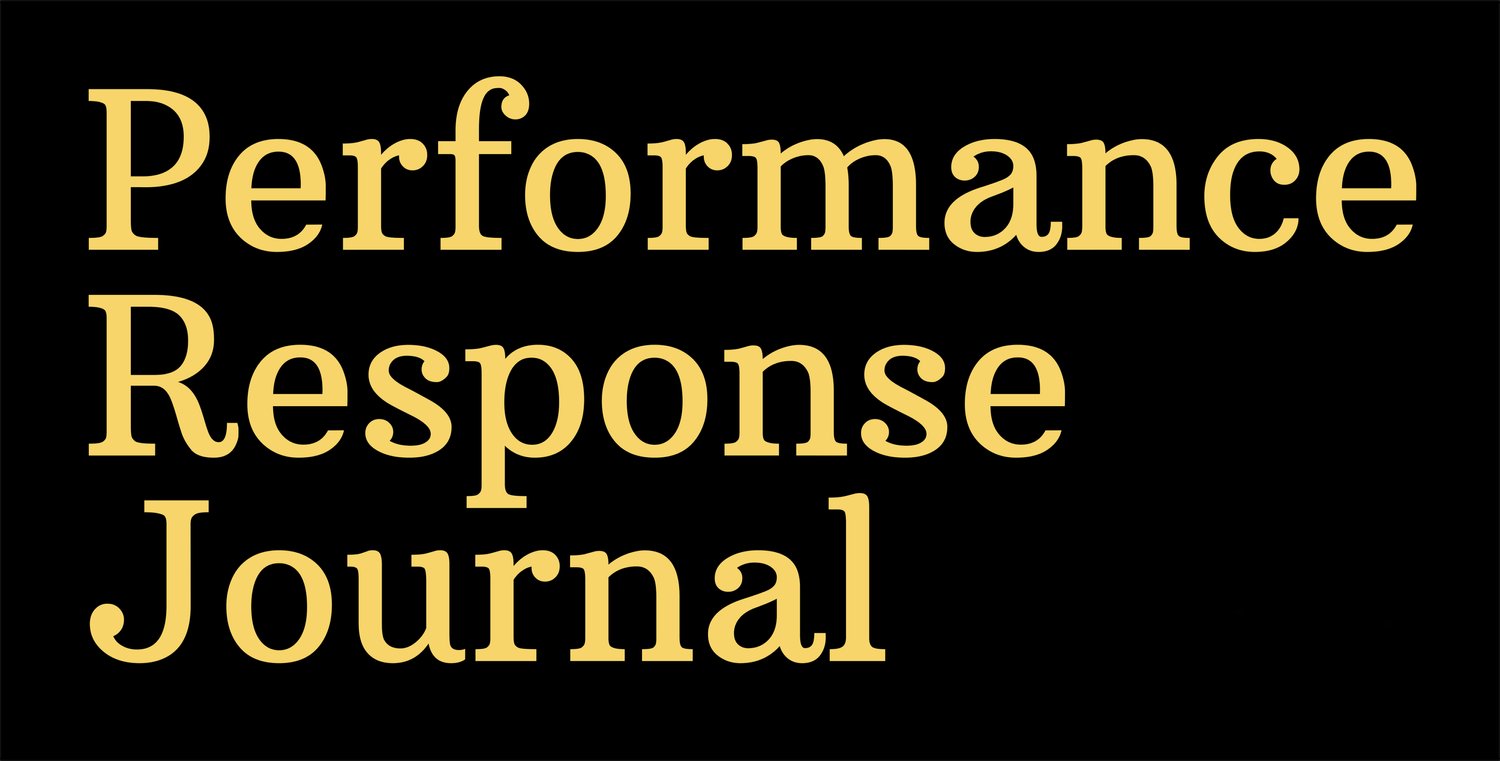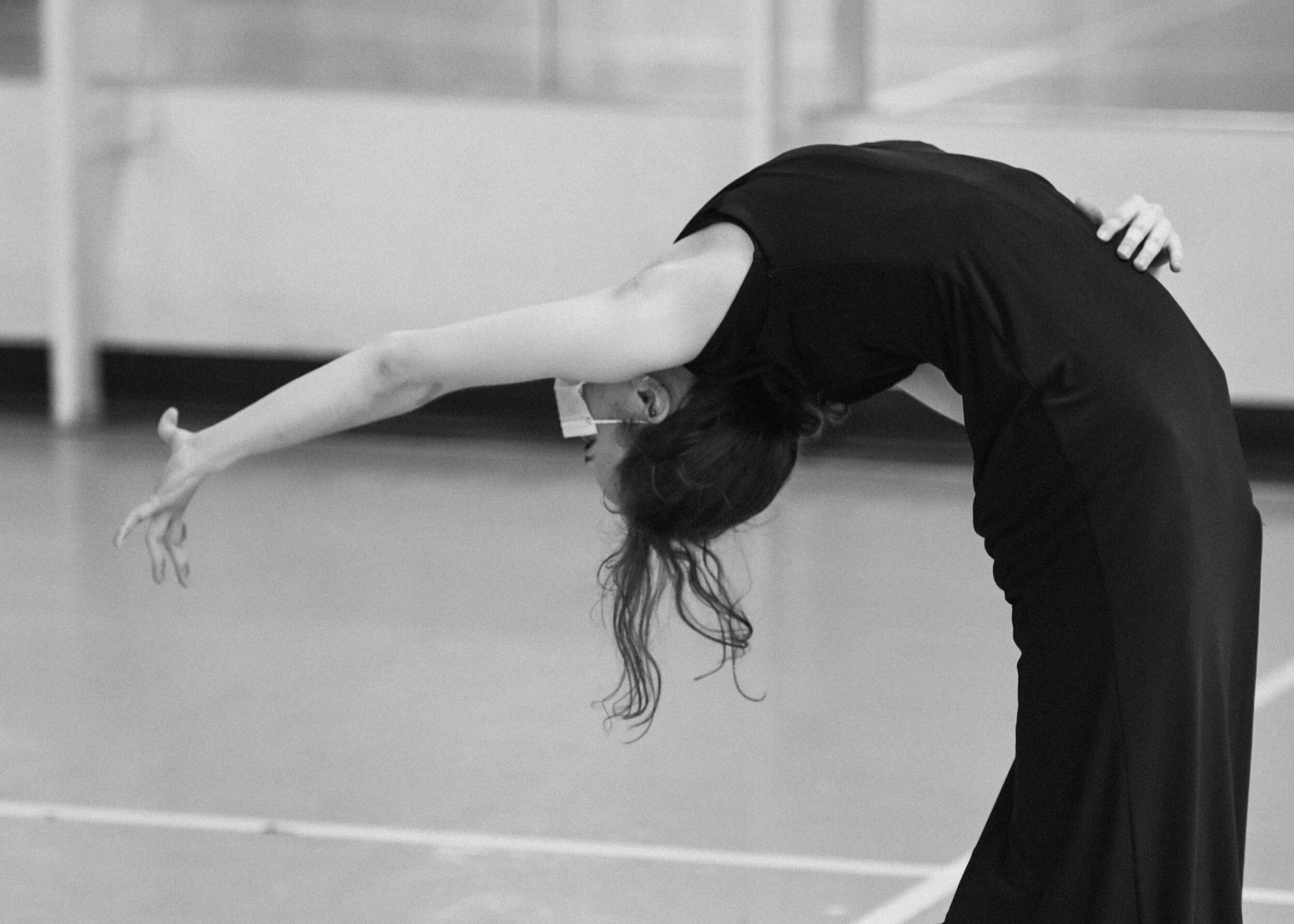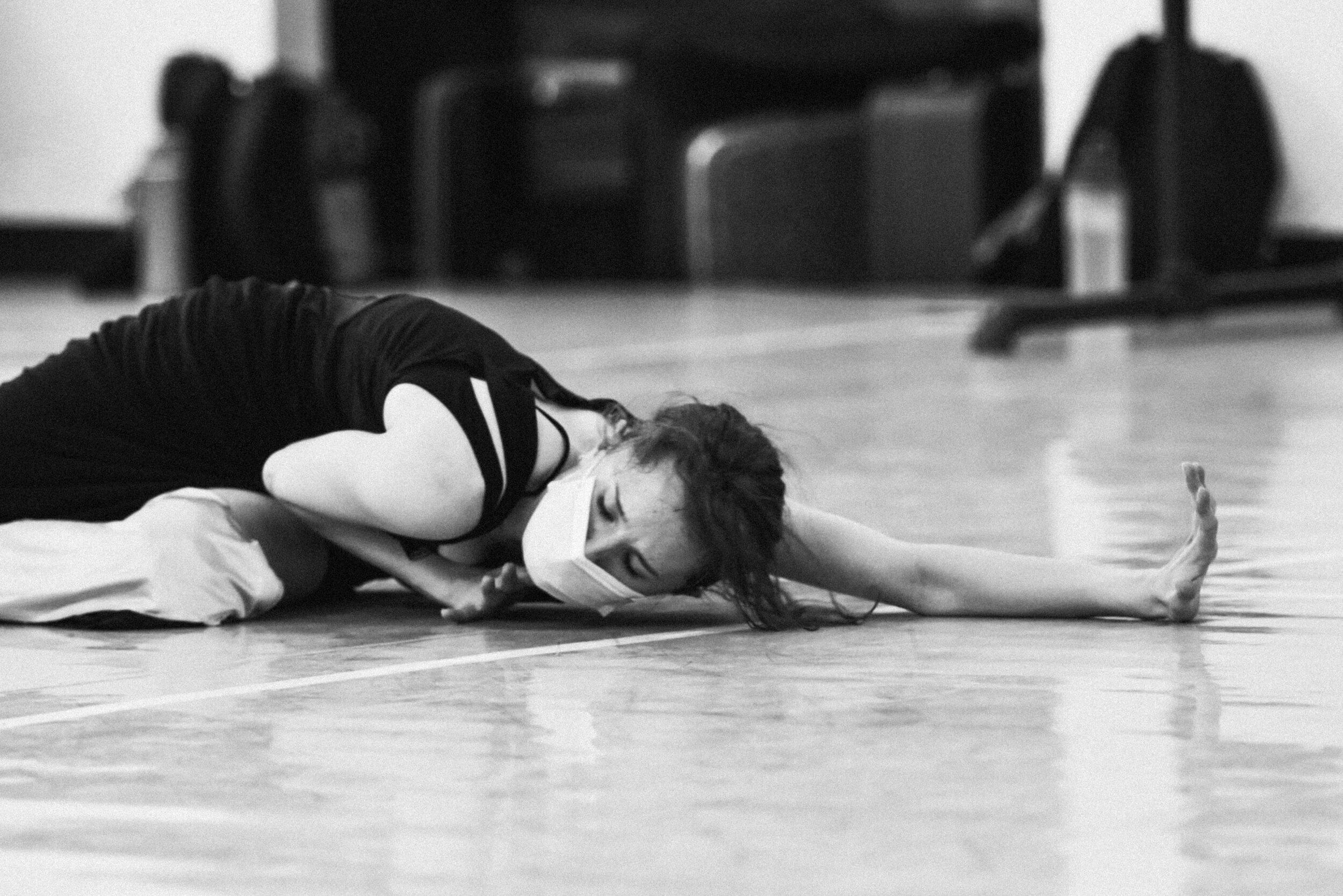Hacia la luz: a response by Katerine Ricardo
all images by Peter Hinsdale of dancers Paige Kingston and Ari Elle Yao
From March-October 2021, Rigo Saura was in residence working on "Pink Nights Never End” with Ballet Cívico dancers: Paty (Patricia) Cepeda, Paige Kingston, Madeline Kiesel, Ari Elle Yao, and Devyn Simon.
Ruth Page's Ballet Cívico explores together with Rigo Saura's guidance, the need to create another world or at least improve the one we have.
This is the second response from embedded writer, Katerine Ricardo, to Rigo Saura’s production residency at the Ruth Page Center for the Arts sponsored by the Chicago Dancemakers Forum & the Performance Response Journal.
********************
5 de abril del 2021
Querido Rigo,
Agradezco mucho el que hayas filmado este ensayo para de alguna manera poder asistir a un momento tan íntimo en el proceso creativo. A continuación, te cuento, como pediste, mi primera impresión, la más cruda y sincera luego de ver tu pieza.
Fue notoria la sensación de paz, de calma que esta pieza me trajo, siento una sensibilidad en el decir de cada elemento, en la música, en los silencios, tanto sonoros como de movimiento, en la cadencia kinésica. La escena en que las intérpretes corrían desesperadas, como buscando algo, se disfruta mucho el sentido de urgencia que transmite, me trae un cierto conflicto que a mi entender se resuelve muy pronto. Creo que esta parte hay que tenerla en cuenta como un fragmento importante y de peso por presentar un conflicto, porque rompe con la calma que trae la obra, porque es pura acción, sin adornos y, hasta la manera repentina en que termina es inquietante. Todas estas sensaciones que me hizo sentir como espectadora ahora hay que ver donde las quieres ubicar. Acá me enfocaría más en la interpretación de las bailarinas y en hacer conciencia de qué es lo que buscan o por qué van de un lado a otro. ¿Qué es lo que ven en ese final? ¿un abismo, ven a esa persona, ven su pasado? ¿Qué les pasa con lo que ven? Que no sea solo la pauta kinésica sino también el sentido y entonces va a ser mucho más fácil que entiendan, que estén conectadas y por lo tanto que el movimiento se vea lleno, con peso, con sentido. Teniendo en cuenta todo esto ¿podría este fragmento ir más hacia al final? De cualquiera manera estaría bueno que sepas de la importancia que tiene y lo puedas desarrollar, profundizando capaz en el sentido de urgencia, o el tema de la búsqueda, o el desequilibrio del espacio, lo caótico o la sensación inquietante que provoca, son algunos puntos de partida que vienen a mi mente.
El fragmento que le sigue me pareció súper poético, sensible muy disfrutable, me regresó esa sensación de paz de la que hablaba al principio. La interpretación la sentí en todo momento conectada con la luz, con la emoción, con su danza, es uno de los momentos felices de la obra. Cuando las intérpretes caminan por el espacio mientras solo una de ellas baila, me traen una sensación espectral de almas que divagan, como otra manera de búsqueda, te lo comento por si te sirve lo explotes o lo repienses sino era tu intención.
Y ahora que menciono la luz te digo que me pareció muy acertada como metáfora, como recurso, la sentí como un personaje más de la obra y eso lo aprecio. Cada momento tiene significados diferentes como ese juego del principio en el que la intérprete la tiene en sus manos mientras baila y se redescubre a sí misma a la vez que busca algo afuera. Todas parecen buscar la luz y a cada una de ellas les provoca algo diferente. La intérprete que se arrastra atraída por o hacia la luz, a que al final baila para esa luz que parece inalcanzable por más que esté frente a sus ojos. Necesita a esa luz para moverse a la vez que si se acerca le enceguece; como ese ideal de amor en el que te haces daño a ti misma en el intento de atraparlo. Me hizo recordar el poema “Ama el cisne salvaje” de Noguera, te lo dejo al final por si le aporta algo a tu proceso creativo. Esa luz también me provoca algo a mí como espectadora, en un primer momento molesta, hasta que me adapto la empiezo a entender y la disfruto.
Siento que la obra ya está en términos de dramaturgia. Me parece que ahora sería hacer consiente lo que cada parte está comunicando y lo que tú quieres comunicar para de esa manera ampliarla, acortarla en tiempo o lo que sea que necesite. Rescato la elección de que todo suceda en escena, frente a mí, sin artilugios, es un elemento más que le aporta a la sinceridad con que está hecha esta obra.
¿Vas a usar máscaras en la obra como elemento de vestuario? Porque la máscara también construye sentido.
Te abrazo,
Katerine
all images by Peter Hinsdale of dancers Paige Kingston and Ari Elle Yao
April 5, 2021
Dear Rigo,
I am very grateful that you filmed this rehearsal for me to somehow be able to attend such an intimate moment in the creative process of this piece. Next, as you asked, I will tell you my first impressions, my raw and most sincere thoughts, after seeing your work.
The feeling of peace and calm that this piece brought me was notable. I feel sensitivity in the execution of each element, in the music, in the silences (both sound and movement), in the kinesthetic cadence. The scene in which the dancers ran desperately as if they were looking for something—the sense of urgency that this scene transmits is very enjoyable; for me, it instigated a certain conflict that was resolved quickly. I think that this portion that presents the conflict is an important and weighty fragment of the work. After all, it breaks with the calm that the work brings; it is pure action without adornments, and even the sudden way in which it ends is disturbing. These sensations I experienced as a viewer made me think: where do you as the choreographer want to place them? Here I would focus more on the dancers’ interpretation and on figuring out what they are looking for and what motivates them to move from one side of the stage to the other? What do you they see in that ending—an abyss? Do they see that person? Do they see their past? These are perhaps questions to start working on in the acting or interpretation part of the process. What happens to the dancers when they see what they see? Whatever the answers are, it’s important for the dancers to consider these questions. In doing so, they will realise that it is not only the body work, but also the emotion behind it. In this way, it may be easier for them to feel that they are connected to the work and therefore every movement will appear loaded, with weight and with meaning. Considering all this, could this fragment be moved further towards the end? Either way, it would be good for you to know the importance it has and can you develop it, maybe going deeper into that sense of urgency, or into the topic of their search, or the imbalance of the space—the chaotic or disturbing sensation that this scene causes. These are some starting points that come to mind.
The fragment that follows seemed to me super poetic, sensitive, and very enjoyable. That feeling of peace I wrote to you about earlier returned to me here. In this section of the work, I felt the dancer was always connected to the light, to the emotion, to the dance; it is one of the happiest moments of the piece. The moment when the rest of the performers walk through the space while only one of them dances, this brought me the spectral sensation of wandering souls searching. I’m telling you this in case it serves you, so that you can either exploit this sensation or rethink it if it was not your intention.
And now that I mention the light, I want to tell you that it worked very successfully as an additional resource for your composition. I experienced The Light as one more character in the work and I appreciate that. Each moment with The Light has different meanings, for example that game at the beginning in which the dancer holds it in her hands while she dances and in the process of searching for something external, actually rediscovers herself. All the dancers seem to seek The Light and The Light provokes a different reaction in each one of them. For instance, the dancer who drags herself attracted by seemingly unreachable light, dancing for it perhaps unaware that The Light is right in front of her. It’s as if she needs that light to move but at the same time if she gets too close to it, it will blind her; just like that myth of love that in which you must hurt yourself in trying to catch it. It reminded me of the poem “Ama el cisne salvaje” by Noguera. I'll leave the text of that at the end of my letter in case it adds something to your creative process. The Light also provokes something for me as a spectator; it bothered me at first, until I began to adapt and to to understand and enjoy it.
I feel like the work is already there in terms of dramaturgy. It seems to me that now would be a good time to make conscious what each part of the work is communicating so that you can amplify these moments, reduce them, or do whatever you need. Finally, I want to emphasize how much I love that everything on stage occurs in front of the viewer without artifice or stagecraft—that the dancers never exit the stage to change or to wait for an entrance, for example; this choice you have made with respect to transparent staging is yet another element that contributes to the sincerity with which the entire work is made.
A final question: Are you going to use masks in the final piece as a wardrobe item? Because the masks also construct meaning.
Big hug,
Katerine
Ama el cisne salvaje
No intentes posar tus manos sobre su inocente
cuello (hasta la más suave caricia le parecería el
brutal manejo del verdugo).
No intentes susurrarle tu amor o tus penas
(tu voz lo asustaría como un trueno en mitad de la noche).
No remuevas el agua de la laguna no respires.
Para ser tuyo tendría que morir.
Confórmate con su salvaje lejanía
con su ajena belleza
(si vuelve la cabeza escóndete en la hierba).
No rompas el hechizo de esta tarde de verano.
Trágate tu amor imposible.
Ámalo libre.
Ama el modo en que ignora que tú existes.
Ama al cisne salvaje.
–– Luis Rogelio Noguera
all images by Peter Hinsdale of dancers Paige Kingston and Ari Elle Yao
11 de junio del 2021
Querido Rigo,
Me tomo este instante en el ajetreo del cotidiano para escribirte porque no quiero que pase un día más sin decirte cuanto agradecí formar parte de Pink Nights Never End. Admiro el ser parte de un proceso que creció tanto desde aquel primer ensayo hasta esa primera función con público. Aprecié ver a las intérpretes seguras en sus movimientos y emociones en escena, con un propósito. Se notó mucho el trabajo que, aunque fue poco tiempo, trajo muchos frutos por la pasión que le pusieron todes, desde tu dirección y coreografía, Sarah y sus luces, y por supuesto las intérpretes de Ruth Page.
Lo único que tengo para hacerte saber es que sentí que siempre hubo información de fuentes sonoras ya sea música o textos y, recuerdo que en ensayos anteriores esto no sucedía. Todo lo contrario, la obra tenía algunos silencios que eran super importantes para la pieza y para mí como espectadora, eran especies de descansos sonoros que esta vez necesité. Es un trabajo que entiendo que le quieras dedicar mucho más tiempo pero que ha crecido y que muchas de las cosas que habíamos hablado anteriormente fueron resueltas de maneras muy sutiles e inteligentemente ubicadas según las necesidades de la pieza. Te felicito una vez más y te agradezco el que hayas incluído mi voz en el poema que escribí para Uds., me llena el corazón de alegría.
Un abrazo y hasta el próximo encuentro creativo,
Katerine.
June 11, 2021
Dear Rigo,
I take this moment in the daily hustle and bustle to write to you now because I don't want another day to go by without telling you how grateful I am to be part of “Pink Nights Never End.” I feel the value of being part of a process that has grown so much since that first rehearsal to that first performance with a live audience. I so appreciated seeing the dancers confident in their movements and emotions on stage, all interpreted with a purpose. Although it was only a short time, the work that each participant put forward was very notable. The performance reaped the rewards of the passion that everyone involved put into it—from your direction and choreography, to Sarah and her lights, to the dancers of the Ruth Page Civic Ballet Training Company.
One final item of feedback: during this performance, I felt that a constant inundation of information from sound sources, be it music or texts, and I remember that in previous rehearsals this did not happen. On the contrary, previously the work had some silences that were important for the piece, and for me as a spectator, they were respites from sound that I felt this time I needed more of.
I know that you want to dedicate more time to refining this piece, but know that it has grown so much and that many of the issues that we had previously discussed were resolved in very subtle and ingenious ways according to the needs of the piece. I congratulate you once again and I thank you for having included my voice in the poem I wrote; it fills my heart with joy.
A hug until the next shared creative project,
Katerine.




